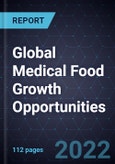Collaborative Efforts Between Drug Manufacturers and Medical Food Manufacturers to Boost Growth Opportunities for Medical Food
The US FDA defines medical food as “a food, which is formulated to be consumed or administered enterally under the supervision of a physician and which is intended for the specific dietary management of a disease or condition for which distinctive nutritional requirements, based on recognized scientific principles, are established by medical evaluation.“ Medical food is interpreted as 'food for special medical purposes (FSMPs)' in several countries, including Europe, India, China, and Australia and New Zealand. In Japan, medical food is interpreted as 'food for sick'. In Canada, medical food is governed by food for special dietary use (FSDU) and infant food regulations.
Globally, the regulatory landscape for medical food is not clearly defined, even in developed economies. As medical food is not intended to prevent or treat diseases, it is not subject to the same regulatory requirements as pharmaceutical drugs.
This study aims to understand the role of a medical food in patients' recovery. It provides qualitative and quantitative analyses of medical food ingredients and finished products of medical food.
By ingredient, the medical food market is divided into vitamins and minerals; protein ingredients (animal and plant); nutritional lipids; prebiotics; and others (amino acids and probiotics). Of these, protein ingredients held the majority share of 64.0% (2021) in the total medical food ingredients market due to the important role they play in trauma and illness recovery.
Geographically, the study covers North America, Europe, Asia-Pacific, and Latin America and the Middle East and Africa (LAMEA). North America and Europe accounted for most of the market share for both medical food ingredients and finished product medical food in 2021 due to rising physician awareness and increasing medical adherence by patients. Factors supporting market growth in these regions are the expanding geriatric population, the prevalence of chronic diseases, and policymakers' growing emphasis on malnutrition management.
The impact of the COVID-19 pandemic is taken into account in the analysis. The pandemic induced both positive and negative changes in the medical food market. Supply chain disruptions due to the shutting down of processing facilities and other lockdown measures affected the sale of ingredients and finished medical food. However, the negative effects were reduced to some extent due to the growing consumer awareness and research highlighting the benefits of a medical food in patients' recovery.
Key Features
By finished product, the medical food market is segmented by type, mode of administration, and application.
- By type, the medical food market is fragmented into prescription and nonprescription food. Prescription medical food dominated the medical food market with a 60.0% share in 2021 due to strong demand from developed economies for use in fatal health conditions such as oncology health, critical care and trauma, cardiovascular health, diabetes health, and cognitive health. Key market participants, such as Abbott, Nestle Health Science, and Nutricia, offer vast product portfolios of prescription medical food to meet the growing demand.
- By mode of administration, the medical food market is categorized into oral (food or supplement format) and enteral tube feeding. The oral mode accounted for the larger market share of 75.0% in 2021. Preference for orally administered products, ease of availability without prescriptions, and support initiatives are key factors driving demand for orally administered medical food.
- By application, the medical food market is segmented into malnutrition (including oncology health, immune health, and general malnutrition); metabolic health; digestive health; critical care and trauma; diabetes health; cardiovascular health; musculoskeletal health; and cognitive and central nervous system (CNS) health. Malnutrition, metabolic disorders, digestive disorders, and critical care and trauma are the top target diseases for medical food. Brain and cognitive health remain a small segment; nevertheless, it is one of the fastest-growing application areas for medical food.
Table of Contents
Companies Mentioned (Partial List)
A selection of companies mentioned in this report includes, but is not limited to:
- Abbott
- Nestle Health Science
- Nutricia








